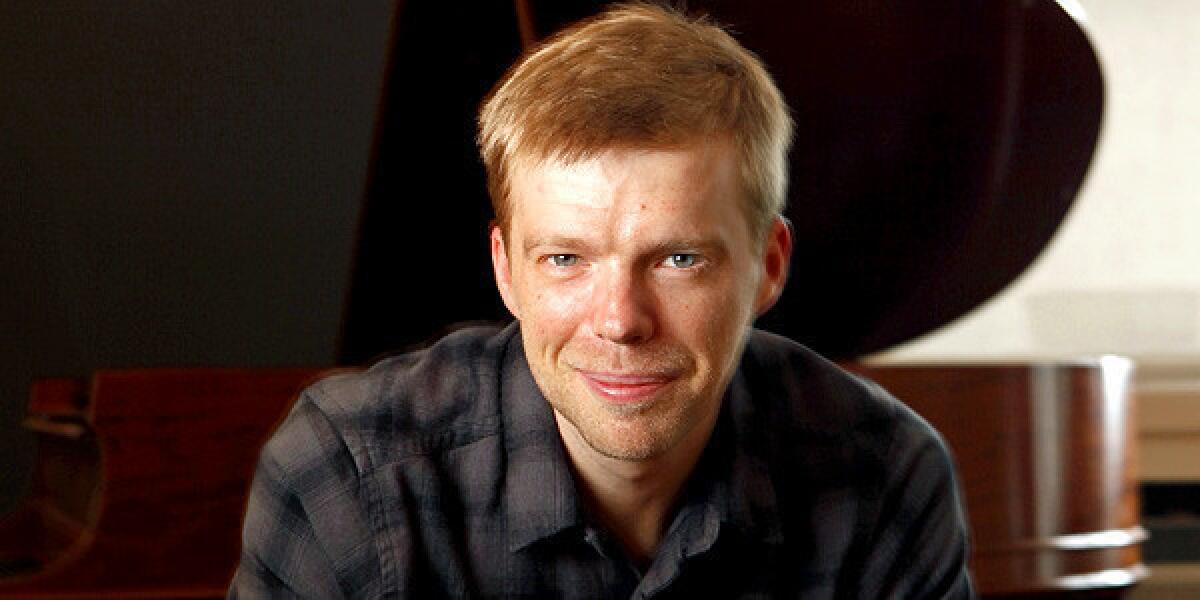Review: Andrew Norman a sound investment at Brooklyn Festival

- Share via
There is little mistaking California’s 22nd largest city for Brooklyn, N.Y., to say nothing of the literally lifeless Glendale section of western Queens, adjacent to Brooklyn. Unlike New York City’s Glendale, ours has, despite accommodating Forest Lawn, more living than dead (Glendale in Queens is home to many cemeteries). But despite its vitality, our Glendale hardly has a Brooklyn hipster vibe (although its Armenian restaurants may attract the occasional nearby Atwater Village artist).
Nor was there much reason for mistaking the Los Angeles Chamber Orchestra’s entry into the Brooklyn Festival — initiated by the Los Angeles Philharmonic — for an orchestral work by one of the Brooklyn composers swarming around Walt Disney Concert Hall last week. Andrew Norman’s experimental “Music in Circles III” on Saturday night at Glendale’s Alex Theatre, LACO’s latest commission in its Sound Investment program funded by audience donations, operates in a sonic world very much its own. I couldn’t detect any direct connection to the pop world in it.
Festivals ask for generalizations. What is it about Brooklyn? The six young composers (many Yale-trained) played by the L.A. Phil and its New Music Group last week sounded well versed in popular and folk music along with the most commonplace of classical pieces such as Britten’s “Young Person’s Guide to the Orchestra” and Copland’s “Billy the Kid.” Brooklyn has a lot of history and is a slower society than Manhattan. Perhaps sowing old soil appeals more there than breaking new ground.
PHOTOS: Arts and culture in pictures by The Times
Norman is hardly a stranger to popular culture himself. He burst on the scene with his rollickingly hyper “Gran Turismo,” written while he was a student at USC in 2003. Inspired by the video game, the score went on to catch the attention of the Monday Evening Concerts and of Gustavo Dudamel at the L.A. Phil. Norman, however, inevitably followed the flock of West Coast (and other American) composers to Brooklyn.
He now has a foot back in L.A. — oddly enough though, through a Brooklyn connection. This season he became LACO’s composer-in-residence thanks to Gabriel Kahane, the son of music director Jeffrey Kahane and yet another budding Brooklyn composer who has been turning his dad on to his friends.
Maybe it’s maturity, maybe it’s the distance from L.A., but unlike the other more typical early 30s Brooklyn composers, Norman seems to be becoming more experimental (even his title harks back to an earlier experimental style rather than the more folksy current one). He hasn’t lost his aw-shucks manner either. Speaking to the audience before the premiere of “Music in Circles III,” he described his love for systems and for the visual aspects of music, whether coming up with graphic notation or exploring the way musicians move when they make music. He said that the new piece was about transitions, from silence to sound, from stillness to motion. Then he said he didn’t really know what to say and had probably said enough.
CHEAT SHEET: Spring Arts Preview
The opening four seconds are silent, and the sounds heard first were the Alex’s air-conditioner. I would imagine the silent score went on even longer for some, given that its first notated sound was a very, very high and very, very soft violin note possibly out of the range of all but young ears and dogs.
But bustle comes soon enough with frantic tapping and scraping in the strings. The brass play moving, mournful fragments. The winds hold long chords. The piece grows. Phrases move downward. Dynamism recedes back to beginning silence, seeming to be just where it belongs.
Jeffrey Kahane is not a conductor associated with music this avant-garde. But he conducted it with a kind of exacting exuberance that made me wish he were. “Music in Circles III” is a terrific 12-minute piece and it got the great performance it deserves. What has been clear for a while was confirmed Saturday: Norman is on his way.
Might LACO now ask for a few more dollars from its Sound Investment investors to pay for an insert to the program to tell its audience something about the composer and his music?
Kahane took no chances, however, with this Sound Investment. He surrounded Norman’s new score with old LACO favorites. The program began with a Handel Concerto Grosso (Opus 6, No. 11 in A Major), invitingly played by a small string section led by concertmaster Margaret Batjer. Kahane led Mozart’s Piano Concerto No. 22 from the keyboard, something he does with extraordinary fluency. The evening ended with Ginastera’s gracious “Variaciones Concertantes,” each of the 20th century Argentine composer’s soulful variations showing off individual players in the orchestra.
That meant more dead than living composers were performed in our Glendale on Saturday. But it was hard to tell that from the life-giving sparks given off in the performances.
MORE
INTERACTIVE: Christopher Hawthorne’s On the Boulevards
CHEAT SHEET: Spring Arts Preview
PHOTOS: Arts and culture in pictures
More to Read
The biggest entertainment stories
Get our big stories about Hollywood, film, television, music, arts, culture and more right in your inbox as soon as they publish.
You may occasionally receive promotional content from the Los Angeles Times.











